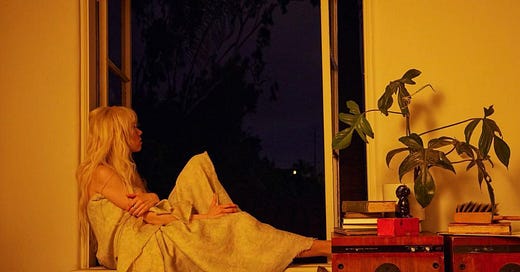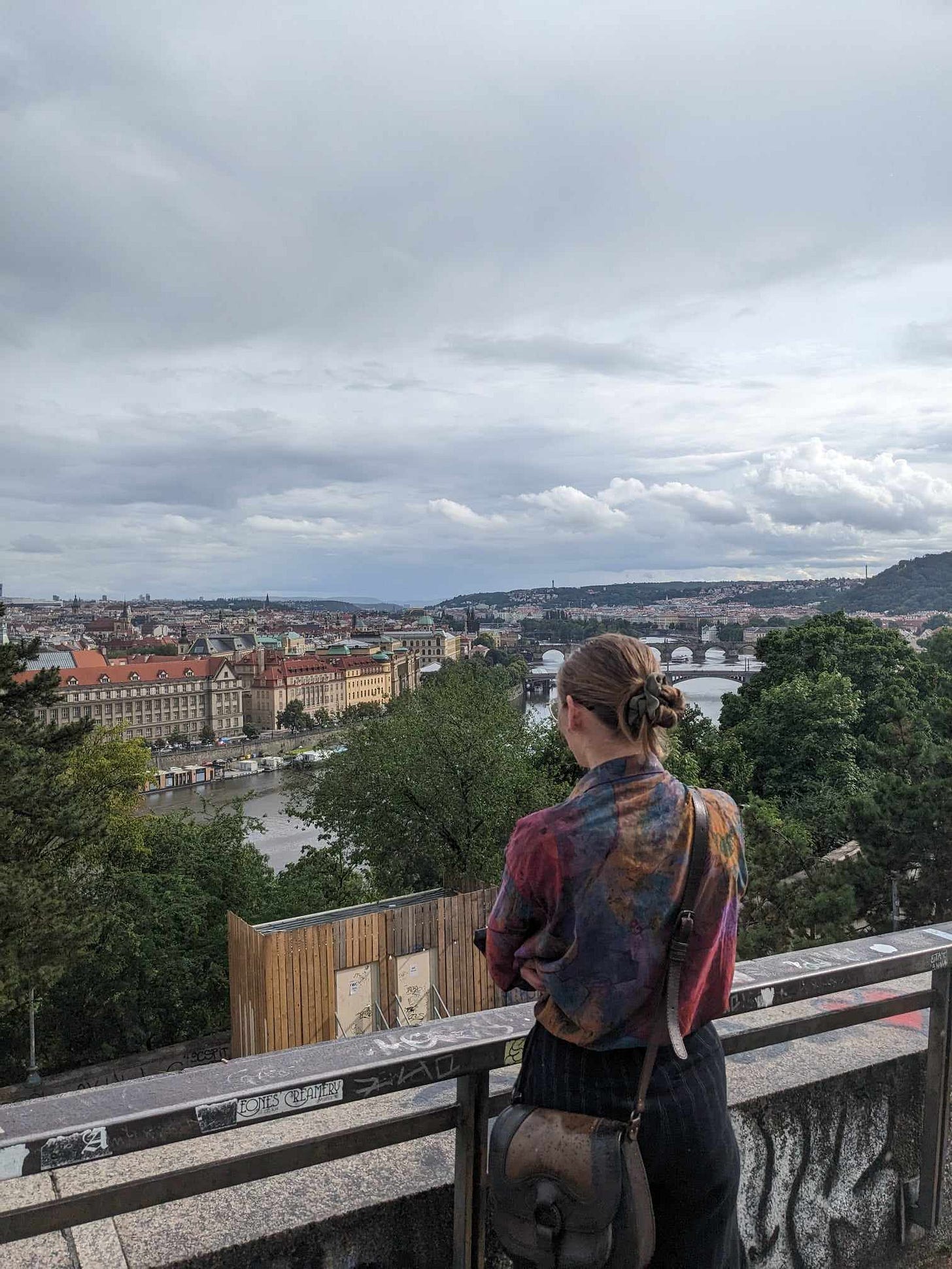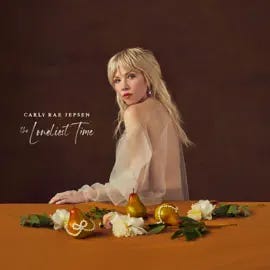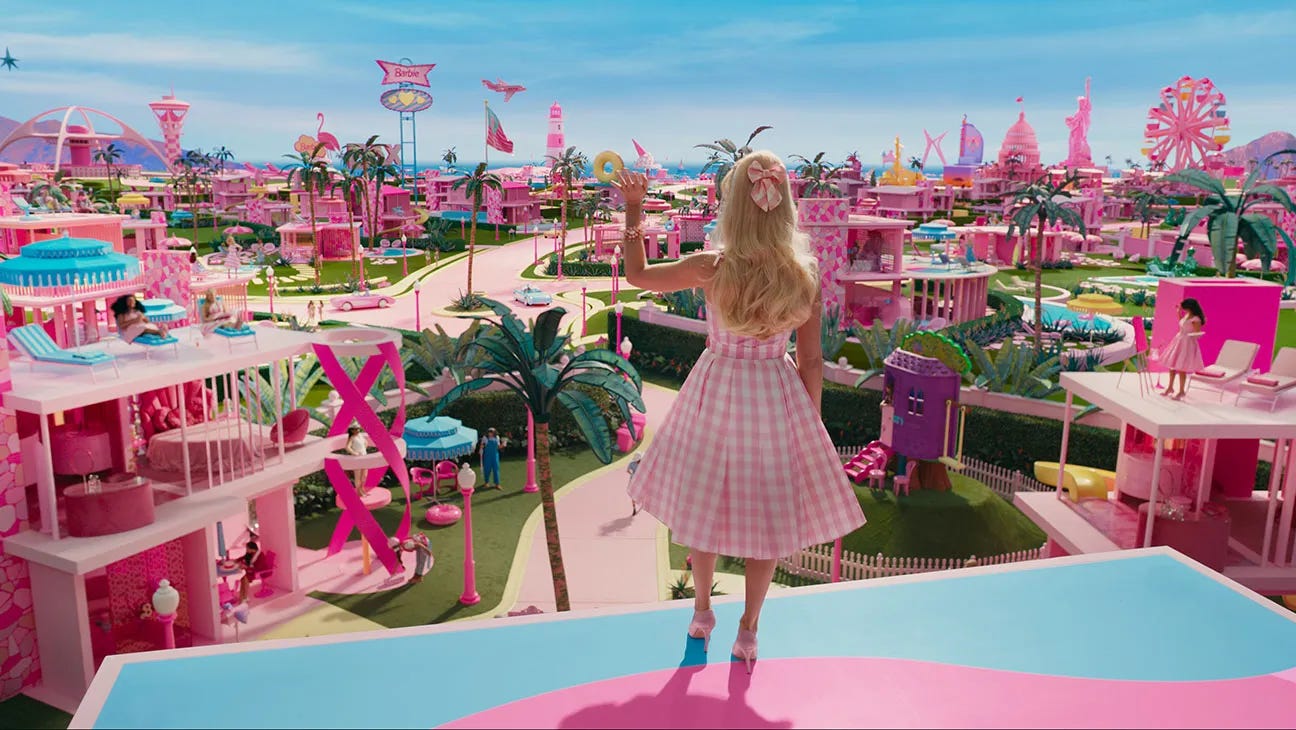Confident, erratic, risky, and earnest
The cult pop queen of Canada, Carly Rae Jepsen, transcends space and time on her latest collection of B-sides
From 2017 until sometime in 2022, I listened to Apple’s 100-song long New Music Daily playlist every single week. I read and watched reviews from major outlets and independent Youtube channels. I was Shazam-ing constantly. Working in a molecular biology lab allows, I would argue necessitates, the wearing of earbuds for at least 80% of the day, so I kept my playlists up-to-date and eclectic. I certainly don’t claim to have been an indiehead: I wasn’t attending concerts underneath bookstores or using SoundCloud. But when major labels decided to throw a bunch of money at a recently-acquired indie darling’s sophomore album, the artist would mysteriously start showing up in my feeds, and it was fun and exciting to know about Phoebe Bridgers and Kali Uchis slightly before their meteoric rises to the mainstream.
I’ve heard it said that once you hit 30, you lose interest in new music: something about being reaching a critical distance from tastemakers (teenage girls) and resorting to familiar comforts and to nostalgia. This sounds like pseudopsychological nonsense, but on the other hand, we refer to artists like The Police and Zeppelin as “dad rock” for a reason. I always maintained I would never lose interest: “as a sophisticated aesthete, I will remain open-minded, in touch with the latest movements, cool, forever,” I thought. But alas, sometime in 2022, I stopped listening to New Music Daily. Now, I skip most of Anthony Fantano’s yellow flannel reviews. My top sixteen most-played songs of 2022 were from one album, and no matter how hard I try, I just can’t get into Ethel Cain. What happened? Did I turn 25 and simply become old? Is my withdrawal from social media disconnecting me from pop culture? Is my millennial showing?
The state of pop
I think we have a decent grip on what early 2010s pop music was at this point. The revival of shameless, brainless artificiality, mostly brought to the mainstream by Lady Gaga’s collaborations with producers like Space Cowboy and Fernando Garibray, and the increasing influence of European producer-DJ-businessmen like David Guetta, Calvin Harris, and the late Avicii meant that the archetypal 2010s pop hit was a Euro-phoric, electronic, and danceable torch song, usually featuring a rapturous and vacuous vocal performance from a heavy-hitter like Sia or an (uncredited) Scandinavian siren like Ina Wroldsen. In 2014, Taylor Swift’s 1989 officially revived ’80s synthpop, and Bruno Mars’ 2016 album 24K Magic brought back funk. Swift and Mars each won Album of the Year at the Grammys, and it seemed like this was just the beginning of a long reign for genre-reviving, nostalgia-invoking, technology-assisted, intentional pop music. I was loving it. Taylor Swift’s “Style” (2014) is possibly my favourite song of all time. But the reign was not to be. In November 2016, Donald J. Trump was elected President of the United States of America, and everything was ruined.
In case you had the strange pleasure of spending the years between 2016 and 2020 in outer space or a cloister, the Trump presidency was, well, a shit show. The quadrennium was defined by kids in cages, rolling back of women’s and LGBT rights, covert meetings with Russian oligarchs, xenophobia, bizarre gaffes, a completely botched response to the COVID-19 pandemic, four (4) press secretaries, two (2) impeachments, and an alleged attempt to steal the 2020 election, which culminated in the January 6 attacks on the United States Capitol Building. It was a time which was reflected by pop music: the late 2010s brought more pensive, melancholic, realistic, and political music to the commercial and critical forefront. Looking at the Grammy Awards during the Trump presidency, the trend is obvious. Childish Gambino’s “This Is America” (2018), a sardonic commentary on systemic racism in the USA, won both Record and Song of the Year. The following year, Billie Eilish later swept the Big Four categories with her pensive 2019 release When We All Fall Asleep, Where Do We Go?. H.E.R.’s “I Can’t Breathe” (2020), written in reaction to the murder of George Floyd, a black man, by Minneapolis police, won Song of the Year after that.
These shifts were also influenced by similar events outside of the USA, such as Brexit, and the rise of right-wing political movements around the globe, and the trend towards realism and politicism in pop music has continued even after the Trump presidency, likely influenced by the COVID-19 pandemic, the associated lockdowns and conflicts over vaccinations, the legacy of the #MeToo movement, and later the invasion of Ukraine by Russia, the overturning of Roe v. Wade, and ongoing climate collapse. Fiona Apple’s Fetch The Bolt Cutters, Phoebe Bridgers’ Punisher, The Weeknd’s After Hours, and Taylor Swift’s Folklore, all concerned with gender, politics, and mental health, defined the pandemic lockdown periods of 2020, and The 1975 and Lorde released the explicitly climate-conscious albums Notes On A Conditional Form and Solar Power, respectively, in 2020 and 2021.
Don’t get me wrong, I was loving all of this reflection of the times. I needed it. I was living alone in a basement in Vancouver, breathing wildfire smoke and dealing with a less-than-ideal work situation on top of all the worldwide goings-on. Not only did I learn more about the experiences of women and racialized people in my community, but I also simply needed something to reflect the isolation and fear I felt. I was living for Miley Cyrus’ self-reflections on Plastic Hearts and Lana Del Rey’s introspection on Blue Bannisters (both 2021). I vegged out on the beach in 35°C weather to Khruangbin’s spacey Mordechai (2020) and ran my fastest kilometres ever to the rage of Halsey’s If I Can’t Have Love, I Want Power (2021). But by 2022, as the world started to get “back to normal” (absolutely hate that phrase, don’t even get me started on how we never had and never will get to “normal”), I think I started to get a little exhausted by culturally conscious songwriting. I’m pretty comfortable articulating my sociopolitical angst at this point: Donald Trump is the presumptive nominee for the 2024 Republican nomination, I just visited Czechia and learned about the legacy of Russian imperialism in Eastern Europe, and my home country of Canada is having its worst wildfire season ever. I’m aware of the challenges we face, and right now, I’m not exactly looking for a reflection of that in my pop music.
The nEw nOrMaL
And so, here I am, at not even 30, falling out of love with new music and young artists. I don’t care about Olivia Rodrigo or Ice Spice. I don’t recognize most of the names on the Billboard Hot 100. I’m not even sure I listened to the current Album of the Year, Harry’s House (Harry Styles, 2022), in its entirety. Instead, I’ve spent the past year absent-mindedly revisiting pre-Trump, pre-Brexit, pre-everything music: Arctic Monkeys’ AM (2013), Lady Gaga’s Artpop (2014), The Zolas’ Swooner (2016), and Taylor Swift’s re-recordings of her early-2010s albums. You might accuse me of nostalgia for a perceived simpler time, of being reactionary, and you might be right.
Since exiting the dumpster fire of a life I was, uh, allegedy living in Vancouver, simultaneously experiencing the relaxation of fears surrounding the pandemic, and incidentally removing myself from the most eminent perils of climate catastrophe by moving overseas, I’ve had the chance to reacquaint myself with my personal needs. My caffeine addiction is under control. I’ve worked on my relationships with my family. I’m travelling, going to concerts and clubs, meeting up with friends, and taking risks again. I’m asking myself questions about and holding myself accountable for my future goals. I’m excited about all that, and I’ve started longing for music to encourage me not necessarily to forget about the injustices of the world, but to be aware of them while figuring out how to resume living my life.
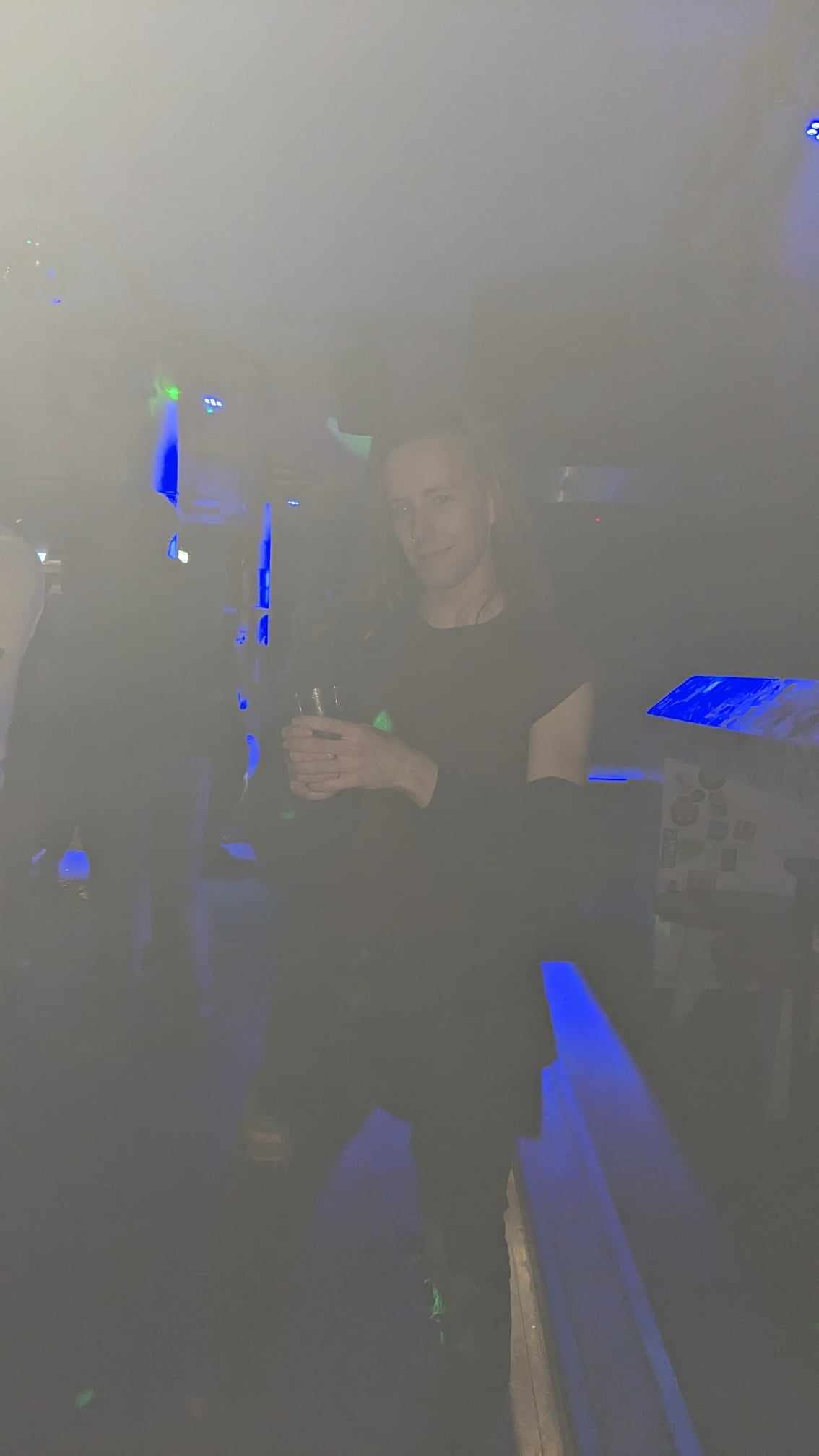
This is not to say that I don’t like new music; most of my favourite albums of the past year were obviously influenced by recent tumult: they chronicle the collective trauma of lockdown and isolation, the collective mourning of our lost years, and the collective anxiety for what’s to come. Alvvays’ Blue Rev (2022) speaks to my feeling of being left behind by time and my peers post-pandemic. On the other hand, Alex G lets lost time go and chooses to retreat to certainty on God Save The Animals (2022). Paramore’s This Is Why and Portugal. The Man’s Chris Black Changed My Life (both 2023) struggle with the unstoppable passage of time, while also explicitly reacting to the Trump era of populist and racist politics. Taylor Swift and Lana Del Rey are preoccupied with pre-pandemic conflicts and tragedies and try to turn lessons learned into strength on Midnights and Did You Know That There’s A Tunnel Under Ocean Boulevard (2022, 2023, respectively). Let’s not forget about the climate: my only Gen-Z-relevant conaissance, Geese, imagine on 3D Country (2023), in the middle of a raucous country-rock song, “New York City, underwater.”
This year, these albums have soundtracked the paradoxical melancholy of my privileges: rainy bike commutes to the lab, struggling to read French philosophy in my bedroom, sleepy train rides through the European countryside, and long, overpriced flights between the UK and Canada that someone else paid for. Alex G’s pitch-shifted vocals and dissonant synthesizers are basically hypnogogic for me at this point; these albums don’t exactly exalt me towards much action or ambition. I noticed I haven’t listened to any of these albums while running: since I moved to the UK, I have always listened to something old when I’m working out, until just a few weeks ago, when everything changed. On July 28, 2023, I was minding my own business, cycling around the city trying to buy Czech koruna for a trip to Prague the next day, when I received a notification: “New music from Carly Rae Jepsen is available.” Canada’s cult pop queen, Carly Rae, had released her latest B-sides compilation, The Loveliest Time.
Fans of Carly Rae Jepsen have gotten used to B-sides: since 2015’s E•MO•TION, each of Jepsen’s pop “eras” have consisted of a main release, plus a slightly mysterious, less promoted, “B-sides” follow-up record, released about a year later. Her method of composition, purportedly writing hundreds of songs for each album cycle only to whittle down the tracklist to the catchiest twelve-or-so songs, means that bona fide bops are left on the cutting room floor every time. So, some are released to thirsty fans via a “B-sides” record. The Loveliest Time is the third of such records, following E•MO•TION Side B (2016) and Dedicated Side B (2020), and for the first time, critics agree with fans that the B-sides are better. Pitchfork gave this cycle’s A-sides, The Loneliest Time (2022), a 6.5, calling it “just fine,” and The Loveliest Time a 7.4, saying “Jepsen’s B-sides are just as good if not better than her A-sides.”
Apologies for the preamble, but what I really want to talk about in this essay, which I’m writing to allow myself to take a break from another project which was supposed to be done two months ago, is this album, which has succeeded at busting me out of my post-pandemic pop depression.
The New Normal: Side B
Unlike her previous B-sides releases, which extended on the lyrical and musical themes of their respective A-sides, The Loveliest Time is thematically antithetical to The Loneliest Time. You can even tell from the titles. Loneliest is preoccupied with the malaise of lockdown isolation, therapized self-loathing, of course, and the tribulations of online dating. Contemporary themes reflecting universal experiences of the times, albeit a little overdone at this point. Loveliest throws the collective consciousness out the window, lets go of the pandemic hangover, and inverts the themes of its sister record. Sonically and lyrically, the album is confident, erratic, risky, and earnest, which is pretty much how I’m trying to be right now. After several years of artists like Lorde and Billie Eilish writing about the ennui of fame, Taylor Swift and Lana Del Rey embedding terminally online phrases into their otherwise timeless lyrics, and SZA unironically writing the lyric “let’s talk about A.I.,” it’s really refreshing to listen to a pop album devoid of heavy-handed self- and cultural reference in the lyrics.
For example, so much of today’s pop music is preoccupied with the influence of the internet and technology on our emotional lives, especially since the pandemic, which drove our social and professional lives online. The A-side single, “Beach House” (2022) chronicles Jepsen’s struggles with dating apps. But, as far as I can tell, The Loveliest Time, still preoccupied with the early stages of relationships, doesn’t mention dating apps, social media, or even texting. The opening spoken word passage in “So Right” is exemplary: set to a four-on-the-floor 808 loop and unassuming bass sequence, we hear a flirtatious exchange between Jepsen and a male voice, the vocals gently filtered to sound like a phone conversation:
Do you really think this is a good idea?
I mean no, probably not, but, yeah
Alright, see you at my place
’Kay, see you soon
It’s silly and romantic in the way Jepsen’s lyrics often are, but what’s memorable about it to me is that it’s such an un-online exchange. Talking on the phone? Making advance plans to meet up? Giving in to temptation? Taking a risk? Tinder could never. A signature Jepsen synth swell (an “SJSS,” if you will) follows, the beat drops, and Jepsen proceeds to recount her history and fears with this relationship. She’s “complimented by [the] invitation,” but wonders if they will “only make each other cry again.” As she says in the introduction, she’s unsure. The situation is the complete opposite of the stringent, hypercommunicative stoicism that online dating and the discourse around it have made the norm, where nothing proceeds beyond online chat, or even to a “match,” unless the express requirements of both parties are fulfilled. I also can’t help but notice the influence of capitalism: at this point, it wouldn’t be such a stretch to use business aphorisms like “time is money,” or “never take the first offer,” in online dating discourse. Incel communities have been appropriating the 80/20 rule for years. The endless social media strategizing about identifying red flags, green flags, yellow flags (whatever those even are) and our fixation on “expectations” protect us from the things capitalism hates the most: wasted time, interference with individual productivity, and the distraction that comes with strong feelings such as heartbreak. I think some of this mentality was brought on by pandemic lockdowns, when our needs for companionship and intimacy became especially salient, and for my generation, the feeling of losing a chunk of our twenties has added some urgency to locking down, so to speak, a life partner. But, what I love about Loveliest is that it pushes back on that urge, encouraging us to take a risk on something, or someone, because “sometimes, we get it so right.”
Throughout the album, Jepsen rejects the project management of romance, opting to throw herself into just about anything with her full face, even if her projections don’t indicate that it will be an optimally lucrative investment. On the fan- and critic-favourite “Psychedelic Switch,” she likens her latest entanglement to a hallucinogenic experience that can be transformative and valuable, despite the certain, eventual comedown, proclaiming that she’d be “satisfied forever with a couple years of this.” “Shadow” evokes the unsure excitement of the beginning of a relationship, and instead of prioritizing work over everything, Jepsen allows intrigue to become a distraction from her self-determined, jet-setting professional life:
And I keep contemplating our situation
There’s no escaping your words are following me
City to city, heartbeat to heartbeat, you got me, you got me
“Stadium Love,” which revels in the thrill of transient relationships and “weekend lovers,” you know, the “ones you can’t imagine you’ll forget,” might contain the album’s thesis statement, or, the phrase best describing its emotional crux. Jepsen celebrates, with the brightest, earwormiest melody she can muster, the inevitable low points of such an audacious lifestyle:
Wishing you a speed recovery
Sliding doors, goodbye, hello, goodbye
Even breakups and breakdowns are addressed with levity, because she knew going in that failure would be a possibility. This is what makes the album’s lyrics so satisfying: Jepsen’s earnestness on The Loveliest Time is not naïve and melodramatic like some of her previous work (particularly the E•MO•TION era, 2015-2016) and most radio-friendly pop hits aimed at a young audience. Rather, Jepsen embraces the unpredictability of her relationships with a confident maturity. It comes across most brazenly in “Kamikaze,” which likens her desire to, well, a self-destructive, high-speed aerial mission:
I know it sounds fatal
I know we made fire
The ending’s real clear
And it won’t take us higher
She’s perfectly aware of the danger, but chooses to proceed anyway. Throughout the album, Jepsen adopts an open-minded but self-aware approach to romance, one which favours strategically relinquishing control, rather than the stoney calculus of online swiping. And I’m inclined to agree: there’s enough serious shit going on that’s completely out of our individual control, so why be so serious when we actually have a choice?
City to city, you got me, you got me
I don’t think that The Loveliest Time intends to simply pretend that the past few years never happened. What is does do is retrospect to the cutting edge of pop innovation, and pushes those ideas forward without getting bogged down by the cultural baggage that preoccupies my other favourite recent albums. Sonically, Jepsen and her myriad producers take us on an high-speed drive around the perimeter of the current pop landscape, sampling its most boundary-pushing ideas. The effect is like how we are able to better appreciate our cities when we see it through the eyes of a visitor. We’re in the passenger seat looking out the window as Jepsen excitedly points towards iconic landmarks and eccentric venues, reminding us that despite the extortionate rent hikes and rampant gentrification, being here is pretty great.
She hits us early with a solid dose of her own ’80s-inspired specialty, complete with filtered arps, big saws, and a soaring chorus, on “Kamikaze,” but on the following track, “After Last Night,” we’re in a completely different neighbourhood. The song features skittering hi-hats that don’t quite constitute a trap beat, instead the song sounds more like something Grimes would sing over on 2015’s Art Angels. The disorienting chord progression of “Aeroplanes” reminds me of some of Dylan Brady’s work with Charli XCX on her 2019 and 2020 releases Charli and how i’m feeling now, but here, it’s played totally straight, without the winking irony that characterized songs like “Click” (Charli XCX, 2019). The single 2/4 measure at the end of each phrase in the chorus is jarring every time, but Carly’s vocal performance doesn’t, uh, miss a beat (sorry). As both Anthony Fantano of theneedledrop and Harry Tafoya of Pitchfork have already pointed out, “Kollage” takes us to the neighbourhood of Tame Impala’s Currents (2015), and the chorus melody of “Shadow,” with its wordy consonance, reminds me of “Now I’m In It” from HAIM’s latest album (Women In Music, Pt. III, 2021).
Late in the tracklist, Jepsen takes us right to the the city limits with the album’s most sonically interesting song, “Put It To Rest.” The anxiety Jepsen expresses in her lyrics is exponentiated by increasingly frantic breakbeats that reference the sample loops of jungle music and drum ’n’ bass, but performed on live drums by Amason drummer Nils Törnqvist. Accompanied by despondent piano and, later, complementary bongo passages, the sequence crescendoes over the course of the song, but ultimately leads nowhere. The song leaves us with nothing but a discordant synth cadence, reflecting the lack of resolution in the lyrics.
Speaking of the boundaries of the pop landscape, you may have heard about the internet’s latest music craze, “Planet of the Bass.” It’s an unsubtle parody of the Eurodance hits that crossed over to the UK and the USA during the ’90s, bringing us guilty pleasure acts like Aqua (“Barbie Girl”, 1997) and Eiffel 65 (“Blue (Da Ba Dee),” 1998). The internet is unironically obsessed with it, and now The New York Times is even asking whether it’s “an ironic hit — or just a hit,” and BBC is calling it the “most addictive song of the summer,” so I have to say something. Don’t get me wrong, its creator, New York-based comedian Kyle Gordon is a genius: the lyrics take us to the hilarious uncanny valley of broken English, Chrissi Poland’s vocal performance as “Ms. Biljana Electronica” is perfectly melodramatic, and the track is eminently danceable. But it’s still parody, not pastiche. The song isn’t good, it’s silly, and it’s definitely not what I hope to hear on a night out next time I go to the continent. Carly Rae Jepsen’s “Psychedelic Switch,” on the other hand, might actually pass for the real thing.

The sonic centrepiece of the The Loveliest Time, “Psychedelic Switch” is an unblinking homage to French house music with swirling, phasing synth layers and just-intense-enough-to-know-it’s-intentional autotune on the chorus vocals. The transitional on-beat open hi-hat hits and grounding, funky bass line are a clear tribute to Daft Punk, and while I know that Kyle Gordon probably wasn’t prioritizing his song’s aesthetic value, I just want to point out that if you’re in the market for a euphoric club banger, Jepsen & colleagues have provided a worthy alternative.
The Loveliest Time erratically drives us around between these musical styles, shifting gears and doing 3-point turns along the way, but it’s not necessarily nostalgic. The attitudes being referenced are mostly contemporary, and at the same time, the lyrics are actually a bit vague: they contain distinct and clear attitudes that disagree with popular discourse, but also leave out the details. It doesn’t feel directly referential to the current culture, but it also doesn’t take us very far back: The Loveliest Time resists placement in a particular time or cultural context, and I think this is part of the appeal. It feels familiar, but not known. It feels relevant, but not trendy. It feels current, but not now. It feels liminal.
Sliding doors, goodbye, hello, goodbye
The liminal, or more popularly, liminal spaces, are a burgeoning topic of discussion online. It’s hard to encompass all the aspects of liminal aesthetics in a Substack essay, so I am going to lean on a recent Contrapoints Tangent by cultural critic Natalie Wynn for help making sure we’re on the same page, and later, respond to some of her arguments. In “Liminal Spaces,” she describes the liminal as:
The in-between. The transitional. A sense of lingering in a place between places, between worlds, between stages of life.
Natalie Wynn, Liminal Spaces, 2023
The most common examples of liminal space images online include hallways, empty hotel lobbies, abandoned playgrounds and malls, empty parking lots, and airport terminals. Images of these areas can evoke an uneasy, melancholic, hopeful, or exhilarating feeling in the viewer. Here’s some examples from the r/LiminalSpace subreddit:




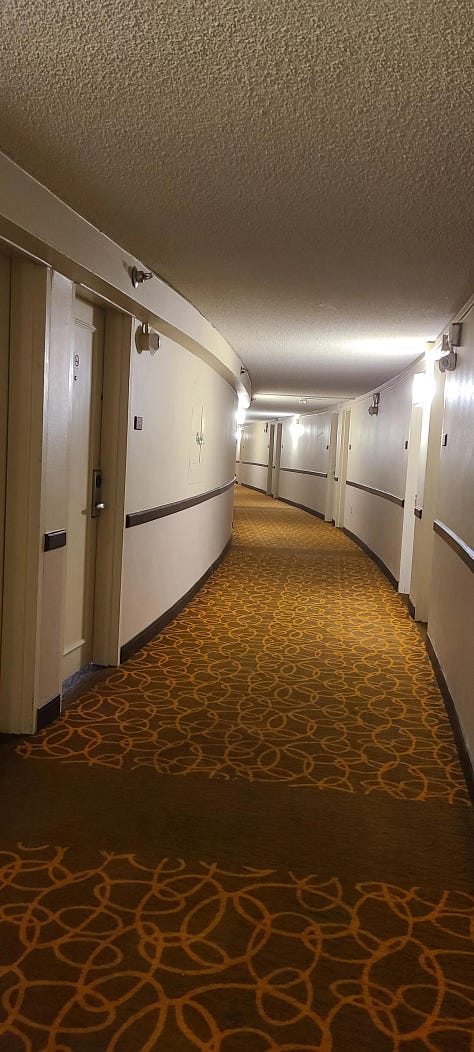
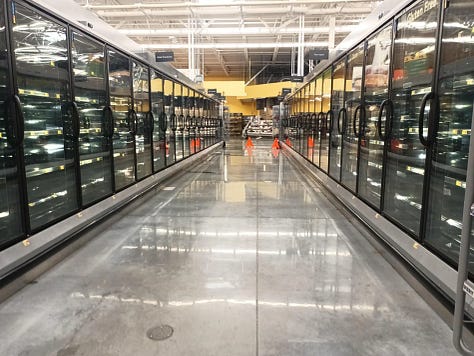
Wynn’s research points towards “a human discomfort with liminality in general: with ambiguity, and with continuums,” [sic] and our society’s tendency to create rituals that alleviate the ambiguity that comes with those in-betweens, for example, the bat mitzvah:
The liminal threatens essentialist categories, and rituals compensate for that threat by making the continuum into a binary, by making it discrete. Adolescence is liminal, it’s uncomfortable, there’s a transition from girlhood to womanhood, which essentialist thinking can’t tolerate. So, the ritual restores clarity, it says, ’yesterday, you were a girl; today you’re a woman.’
Natalie Wynn, Liminal Spaces, 2023
Looking at examples of imagery associated with these transitions from the internet and from films such as the rabbit hole sequence from Alice In Wonderland (1952) and the red-pill-blue-pill scene from The Matrix (1999), she points out common aesthetic elements: series of hallways and doors, dreamlike settings, out-of-place objects, and decontextualized design. Collating these examples, she defines some common aesthetic features that contribute to the overall experience of the liminal:
The Uncanny: The strange within the familiar. Something that used to be homely appears as unhomely.
The Surreal: The juxtaposition of reality and dreams or fantasy.
The Weird: The presence of that which does not belong. The alien.
The Eerie: Something is present where there should be nothing, or nothing is present where there should be something. The eerie implies the work of incomprehensible agents.
The Hauntological: The haunting echoes of a lost future.Natalie Wynn, Liminal Spaces, 2023

Let’s look at how The Loveliest Time embodies the liminal, which might help solidify some of these concepts. Earlier, I described my desire to escape the present moment, or to at least adopt an attitude that accepts, but doesn’t dwell on, the political and personal situation in which I find myself. I admitted that this desire, and escapism in general, might be nostalgic or even reactionary: as Wynn points out, to long for a bygone, simpler time is to prefer an earlier phase of societal progress, one in which I was less aware of societal inequities and the plight of marginalized groups. In many cases, nostalgia is an experience of privilege. But the album is not nostalgic, it’s not purely an ’80s revival like record like Dua Lipa’s Future Nostalgia (2020) or The Weeknd’s Dawn FM (2021) (although these albums, particularly the latter, do also incorporate liminal aesthetics). Loveliest doesn’t transport you back in place and time, to before the pandemic, or before the Trump presidency; it doesn’t seek to restore a state of innocence in which we don’t know about the impending climate collapse. Instead, with its dissonant textures, perfectly vague lyrical content, and absence of self- and cultural reference, it transports us out of place and time, creating a sonic and lyrical liminal space.
First, the dissonant textures: Wynn proposes that a sonic equivalent of a liminal space is the musical genre known as vaporwave, which incorporates “slowed down and looped samples of ’80’s pop music, of ’80s Muzak, mall music, K-mart music,” et cetera. Vaporwave is hauntological: by incorporating electronic samples from the past that imagined a technologically advanced future, it’s nostalgic for how we once thought the future would be. Vaporwave can have an emotional effect because it highlights the disparity between the expectations for the present that we once had, and the present that we actually exist in. Think Tron, think Daft Punk, think elevator music, and think about the consistent markers we associate with these sounds: think about the tinny speakers used in malls and department stores. The most recent embrace of vaporwave in commercial pop music I can think of is Beck’s 2019 album Hyperspace, which combines spacey, retro synths with trap-influenced beats and tightly gated, drawling vocal passages that fade in and out of the mix. It’s worth checking out if you need some examples.

Returning to The Loveliest Time, which opens with an explicit reference to vaporwave: in “Anything To Be With You,” after a short passage of a capella vocals, we hear an equivocal Musak-esque synth melody over razor-thin gated snares, complete with a high-pass filter, like it’s being played out of a mall speaker. Even if you’re not familiar with vaporwave, it’s instantly recognizable, and even if you’re not familiar with the hauntological, it instantly generates a disorienting effect. But, four measures later, the beat drops, the filters are lifted, and suddenly, the first high-speed move between pop styles of the album occurs, bringing us back to the present day. Jepsen and her producers open with a tantalizing taste of nostalgia, but don’t let us linger there. With the ensuing tour of radical, boundary-pushing, and disparate aesthetic styles that follows this moment, the album gives an impression of not existing in any particular time, or any particular reality. Rapidly darting between different contemporary pop sounds that we know and love, the world of The Loveliest Time is uncanny: it is recognizable, but not completely. This also applies to individual textures, like the breakbeats in “Give It A Rest” which are performed on live drums rather than sampled. Other sonic elements, like the jarring 2/4 measure in “Aeroplanes,” are weird: they feel out-of-place. The album’s vast palette of references and styles is also weird: the sounds feel like they don’t belong together, and, borrowed from other pop artists and eras, they don’t belong with Jepsen’s voice. The album’s sonic landscape is both familiar and confusing: it’s surreal. The familiar elements, as mixed-up as they are, are comforting, and for me, the jumbled, experimental quality suggests new creative possibilities that build on its contemporary pop references. Although those new suggestions are disorienting at times, they leave an impression of looking forward; they’re optimistic, they’re aspirational.
The lyrics of The Loveliest Time also have a liminal effect. As Tafoya points out in his review for Pitchfork, Carly Rae Jepsen has never been one to get into the specifics. We listeners don’t have a relationship with Carly’s persona or personal life in the way we do with a more diaristic songwriter such as Taylor Swift. Like Swift’s, Jepsen’s lyrics are highly emotion-driven, but we can’t look towards Jepsen’s public image or relationships to enrich a song’s meaning. This might sound like a drawback, but in this case, the lack of detail contributes to the album’s liminal quality by liberating it from any single personal situation. Instead, the world we enter is ephemeral, just like Jepsen’s experience in “Stadium Love:” “sliding doors, goodbye, hello, goodbye.” We don’t know if the album’s songs describe one or thirteen different relationships, or if they’re even real: the album’s world is surreal. By leaving out information, Jepsen leaves the details in superposition: they occupy infinite possibilities like the budding romance Jepsen contemplates in “Shadow,” like Schrödinger’s cat before we open the box.
Finally, the album is also divorced from any cultural context: against a mainstream pop landscape in which self-reference and use of cultural reference is extremely popular (I’m thinking about Taylor Swift’s infamous “sexy baby” lyric in her 2022 single “Anti-hero”), not incorporating these elements gives Jepsen’s writing an eerie quality - it feels like something is missing. As much as I love the layered meaning afforded to Swift’s lyrics from their place in a real-world context, in the case of The Loveliest Time, I’m happy without the context. In the same way that the album’s liminal sound is artistically optimistic, leaving so much unsaid releases the album’s lyrical world, Jepsen’s relationships, aspirations, her choices, from the constraints of reality into a liminal space of endless possibility. Listening to those lyrics transports me to that same optimistic place; in my life, too, anything could happen.

Liminal elements like these have started showing up around the alternative pop scene lately. Ahead of Caroline Polachek’s recent release, Desire, I Want To Turn Into You (2023), the songstress spoke in interviews about wanting to be less “literal” in her songwriting, and the album similarly incorporates a mishmash of decontextualized sonic references. For example, “Blood and Butter” features both a bagpipes solo and a perpetual canon outro à la “Row, Row, Row Your Boat.” Charli XCX’s 2022 meta-pop masterpiece Crash incorporates vaporwave and nostalgic elements, and a year later still has the online pop intelligentsia (myself included) thinking itself in circles. Like Jepsen, Polachek and Charli challenge the current expectation that songwriters embed the self into every aspect of their music, but I’m more inclined to place The Loveliest Time in a different corner of the alternative pop space: one I’ve given the working title “liminal contemporary.”

The liminal pop girl
There’s been a lot of discussion over the past decade about how the music industry and its marketing practices require female pop stars to endlessly reinvent themselves. Each album cycle, or era, of a “main pop girl’s” career must present a new look, a new sound, and a new narrative, but she must not change so much that she become unrecognizable. If she can’t strike that balance, or if she suffers the misfortune of simply getting too old, her career might as well be over. During the past few years, though, at least three female pop stars have defied this conventional wisdom. The latest releases from Jessie Ware (What’s Your Pleasure?, 2020; That Feels Good!, 2023), Roísín Murphy (Roísín Machine, 2020), and Kylie Minogue (Disco, 2020; “Padam, Padam,” 2023) defy the self-referential, image-focused angle du jour. Lyrically, the albums don’t attempt to extend on the persona of the ingénue, on the canonical twenty-something-year-old pop star trajectory. Take Ware’s What’s Your Pleasure?, for example. At age 35, Ware could have written about the despair of aging or wax poetic about the adventures of her youth. Ware could have been nostalgic, but that would have accepted and performed the expectations the industry tries to force onto mature women artists. She would have been agreeing with the notion that at her “advanced” age, she has nothing new to give, only memories to recall. Unexpectedly, she neither refutes nor indulges that notion, she simply doesn’t acknowledge it. The lyrics of What’s Your Pleasure? are instead sensual, emotional, anticipatory, and optimistic. It’s a dance album centred not around the self, but on, well, pleasure. By existing beyond that paratextual narrative, the album exists in uncharted territory, in a liminal space. It’s hard to know how to approach it. The world it builds is uncanny: we recognize its pop sensibility, but we don’t expect that from a mature artist. It’s also eerie: the mainstream media fails to allow grown women to have sensuality and optimism, but Ware expresses those qualities unabashedly.
Sonically, on the other hand, these albums combine retro and contemporary elements to create a liminal effect of existing outside of time and history. Talking about What’s Your Pleasure? again, Ware incorporates many elements of classic dance music: Euro disco, funk, acid house, new wave, and more, and does so in a bit of a disordered manner. I mean this in a good way: each song on the tracklist has a different set of retro references; the album doesn’t stay in one place for too long. Like on The Loveliest Time, these erratic sharp turns, combined with more modern production elements and vocals, are disorienting but exhilarating. Along with Ware’s lyrics, which, like Jepsen’s, focus more on invoking a feeling than a self-referential, literal, narrative, these sounds build a world away from the present but not quite in the past, instead the album’s world is a separate present.
Liminal contemporary releases are sophisticated but fun, mature but imaginative, technically proficient, but conceptually experimental. It’s this aspect that sets the liminal contemporary style apart from the oft-compared retro pastiche of Dua Lipa’s Future Nostalgia. Lipa’s album, while certainly euphoric, bombastic, and technically proficient, aims to transport the listener to a particular place and time: the ’80s. She’s aiming to replicate a particular feeling, or a memory of a feeling, of nostalgia. On the other hand, the albums of Ware and Jepsen could certainly have a nostalgic effect, but don’t work towards establishing themselves in a particular historical style, rather, they meld many historical styles together to create a more nebulous impression. The visuals emphasize the difference: Lipa released a video for “Physical,” the song itself interpolating Olivia Newton John’s hit song of the same name (1981), in which she recreates the famous Jane Fonda’s Workout video from 1982. Both the interpolation and the video are direct recreations, pastiches. On the other hand, Ware’s music videos for What’s Your Pleasure? pair imagery associated with contemporary queer and feminist art with retro sounds, suggesting the possibility for the reinvention, the recombination, of these ideas into today’s mainstream aesthetics. (I use the word recombination, since many of the dance genres referenced did originate in the black, queer nightlife scenes of New York City and Chicago, but were appropriated by mainstream artists.)
All three artists have had long, illustrious careers, and some might’ve expected them to slow down by this point. Ware and Murphy are mothers, Minogue survived breast cancer, and their fanbases, once reliable, might have aged out of interest in new music. But with these new aesthetics, they are carving out a new artistic space for themselves that connects with critics, who appreciate the experimentation, and more mature audiences, like myself, who might be feeling frustrated with the direction of mainstream pop. Their work exists in a liminal space, a space that is uncanny: familiar, incorporating beloved references and things we know; but one that is not so homely, so comfortable. The space lacks that intimate, self-referential songwriting that we have come to expect from female pop stars, the same songwriting in which we lose interest once maturity overcomes the naïveté of the ingénue. That space might be a little escapist, but it’s not nostalgic: these artists repurpose retrospective references to prospect towards what’s might be to come.
All my longings are in front of me
Carly Rae Jepsen is unmarried and doesn’t have children, but right now, with the release of The Loveliest Time, she is about to turn 38, and I’m comfortable being the first to place her into the pantheon of slightly-aged-out-of-mainstream-appeal retro-influenced songwriters that I call the liminal contemporary subgenre. Unlike her earlier releases, such as E•MO•TION, which sonically, were more straightforward throwbacks (long before Dua Lipa was even on the scene), Loveliest mashes up retro influences and cutting-edge technique alongside her lyricism, which removes both the self from the work and the work from time and place. But it’s not that the album is timeless, it’s just, asynchronous, or, of a different time. Maybe one that didn’t exist, or one that doesn’t exist yet. The album accepts recent and ongoing strife and looks forward, which I think we all need to do.
I feel like I’m in a liminal space right now. The effects of the pandemic on my day-to-day life are over and I’ve been away from my home country for a year. I don’t really know what I’m doing and I don’t really know what’s coming next. I’m in between. I’m transitional. I’m lingering in a space between places, worlds, and stages of life, and that makes me feel uneasy, melancholic, hopeful, and exhilarated. Wynn on the liminal, once more:
It’s a kind of liberation from the past and impositions of social order. [...] By detaching you from the homely, cozy, familiar feelings of nostalgic aesthetics, I feel like liminal aesthetics contain some sort of radical potential. [...] I feel like a renter in this world; home is always an improvised situation. And sometimes, liminal art makes me feel like that’s an exciting way to live. I’m not stuck in some delusion of the past. All my longings are in front of me.
Natalie Wynn, Liminal Spaces, 2023
When we experience the discomfort of the present time, the liminal encourages us to look forward towards possibility and ambition, rather than towards something safe but regressive.
I don’t want “situationships”, “hard-launches”, and a social life that is just as much online as it is IRL. I’m tired of internet neologisms infiltrating both pop songwriting and my self-concept. What I love about this The Loveliest Time is that that it represents the offline, the awkward conversations, the anticipation, the uncertainty of not having access to read receipts. I agree with Wynn: I think that liminal aesthetics can help us get out of the pandemic-induced rut that our culture is in, not by looking backward to a time before, but asking what potential the future might hold.
For years now, close to a decade, I’ve been obsessed with camp aesthetics. I relished in over-the-top, self-referential, messy, lopsided, distasteful art. Camp aesthetics felt more innovative, more sincere, and more human than the mainstream, and I loved how it flew, with technicolour-feathered wings and toucan beak, directly in the face of the safety, polish, infinite processing power, and infinite funding that gives us two Marvel movies and yet another season of Grey’s Anatomy every year. But sadly, it’s time to move on. I still find the unrivalled auteur quality of self- and cultural reference in mainstream music enjoyable, but Barbie (2023) has brought my radical alt-aesthetic of choice to the mainest of mainstreams. Corporations have finally succeeded in selling camp, and the rejection of late-stage capitalism it contains, back to us. Where to next? Well, it might be time to to embrace the liminal, to embrace “radical potential,” to encourage ourselves to keep working towards a just society, towards personal fulfillment, even if we don’t know exactly where that is or what it looks like. It’s a complicated concept, I know. I’m still figuring it out myself. But maybe that means it’ll be a while before they figure out how to sell it back to us, too. Until then, let’s try to enjoy it.

Editorial note: this piece was composed before the transphobic comments made by Roísín Murphy about puberty blockers came to public attention. the new Warholian strongly condemns Murphy's stance and demands a public apology. Puberty blockers are medications used to delay the onset of some of the physical changes of puberty to give gender- questioning youth time to make informed decisions about their own bodies. The effects of puberty blockers are fully reversible.

